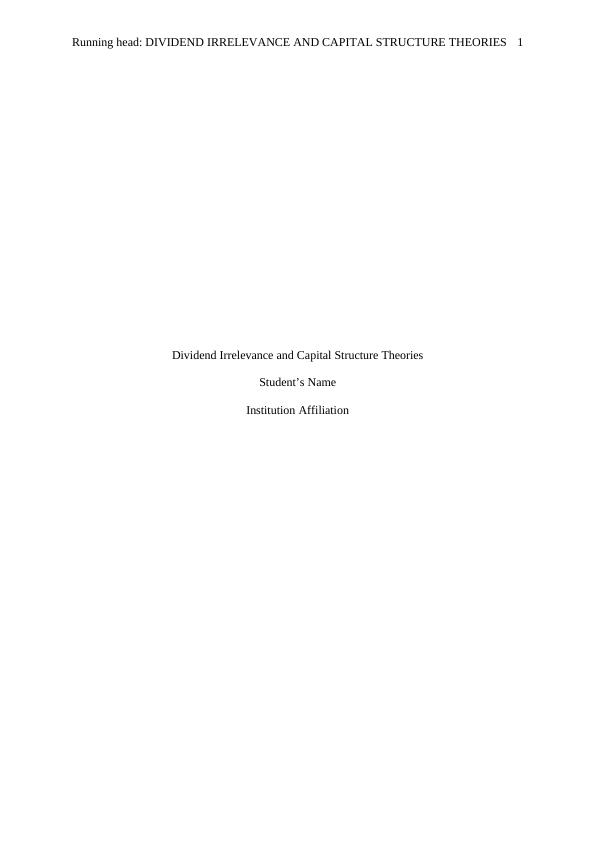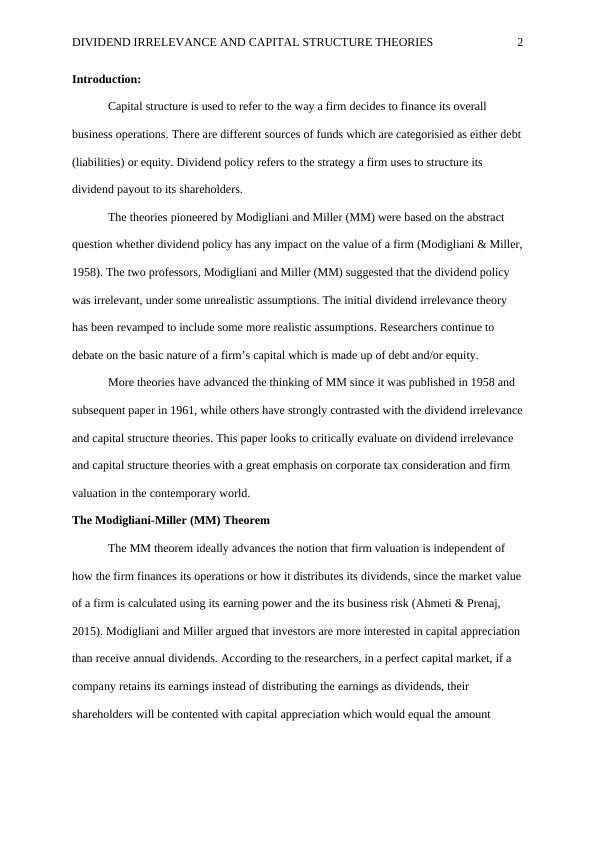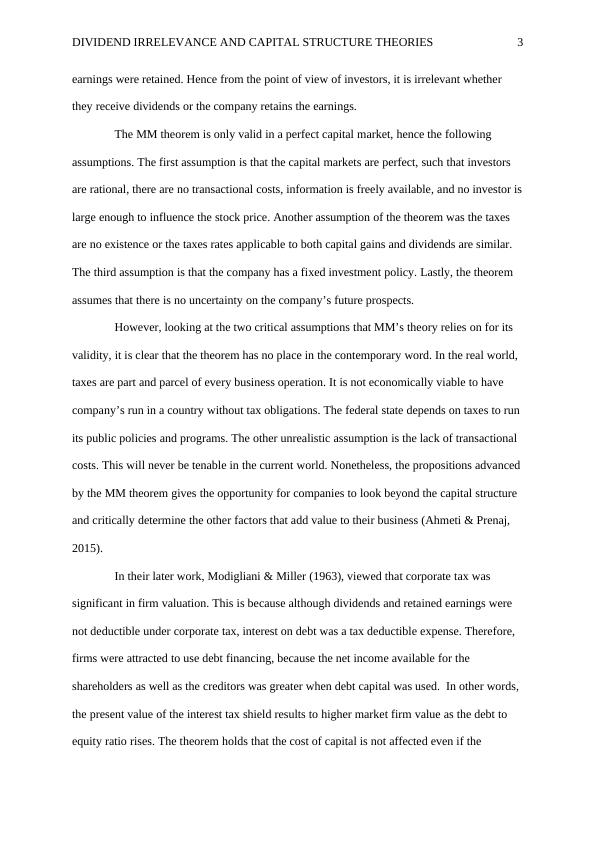Dividend Irrelevance and Capital Structure Theories
Added on 2022-11-26
7 Pages2067 Words323 Views
Running head: DIVIDEND IRRELEVANCE AND CAPITAL STRUCTURE THEORIES 1
Dividend Irrelevance and Capital Structure Theories
Student’s Name
Institution Affiliation
Dividend Irrelevance and Capital Structure Theories
Student’s Name
Institution Affiliation

DIVIDEND IRRELEVANCE AND CAPITAL STRUCTURE THEORIES 2
Introduction:
Capital structure is used to refer to the way a firm decides to finance its overall
business operations. There are different sources of funds which are categorisied as either debt
(liabilities) or equity. Dividend policy refers to the strategy a firm uses to structure its
dividend payout to its shareholders.
The theories pioneered by Modigliani and Miller (MM) were based on the abstract
question whether dividend policy has any impact on the value of a firm (Modigliani & Miller,
1958). The two professors, Modigliani and Miller (MM) suggested that the dividend policy
was irrelevant, under some unrealistic assumptions. The initial dividend irrelevance theory
has been revamped to include some more realistic assumptions. Researchers continue to
debate on the basic nature of a firm’s capital which is made up of debt and/or equity.
More theories have advanced the thinking of MM since it was published in 1958 and
subsequent paper in 1961, while others have strongly contrasted with the dividend irrelevance
and capital structure theories. This paper looks to critically evaluate on dividend irrelevance
and capital structure theories with a great emphasis on corporate tax consideration and firm
valuation in the contemporary world.
The Modigliani-Miller (MM) Theorem
The MM theorem ideally advances the notion that firm valuation is independent of
how the firm finances its operations or how it distributes its dividends, since the market value
of a firm is calculated using its earning power and the its business risk (Ahmeti & Prenaj,
2015). Modigliani and Miller argued that investors are more interested in capital appreciation
than receive annual dividends. According to the researchers, in a perfect capital market, if a
company retains its earnings instead of distributing the earnings as dividends, their
shareholders will be contented with capital appreciation which would equal the amount
Introduction:
Capital structure is used to refer to the way a firm decides to finance its overall
business operations. There are different sources of funds which are categorisied as either debt
(liabilities) or equity. Dividend policy refers to the strategy a firm uses to structure its
dividend payout to its shareholders.
The theories pioneered by Modigliani and Miller (MM) were based on the abstract
question whether dividend policy has any impact on the value of a firm (Modigliani & Miller,
1958). The two professors, Modigliani and Miller (MM) suggested that the dividend policy
was irrelevant, under some unrealistic assumptions. The initial dividend irrelevance theory
has been revamped to include some more realistic assumptions. Researchers continue to
debate on the basic nature of a firm’s capital which is made up of debt and/or equity.
More theories have advanced the thinking of MM since it was published in 1958 and
subsequent paper in 1961, while others have strongly contrasted with the dividend irrelevance
and capital structure theories. This paper looks to critically evaluate on dividend irrelevance
and capital structure theories with a great emphasis on corporate tax consideration and firm
valuation in the contemporary world.
The Modigliani-Miller (MM) Theorem
The MM theorem ideally advances the notion that firm valuation is independent of
how the firm finances its operations or how it distributes its dividends, since the market value
of a firm is calculated using its earning power and the its business risk (Ahmeti & Prenaj,
2015). Modigliani and Miller argued that investors are more interested in capital appreciation
than receive annual dividends. According to the researchers, in a perfect capital market, if a
company retains its earnings instead of distributing the earnings as dividends, their
shareholders will be contented with capital appreciation which would equal the amount

DIVIDEND IRRELEVANCE AND CAPITAL STRUCTURE THEORIES 3
earnings were retained. Hence from the point of view of investors, it is irrelevant whether
they receive dividends or the company retains the earnings.
The MM theorem is only valid in a perfect capital market, hence the following
assumptions. The first assumption is that the capital markets are perfect, such that investors
are rational, there are no transactional costs, information is freely available, and no investor is
large enough to influence the stock price. Another assumption of the theorem was the taxes
are no existence or the taxes rates applicable to both capital gains and dividends are similar.
The third assumption is that the company has a fixed investment policy. Lastly, the theorem
assumes that there is no uncertainty on the company’s future prospects.
However, looking at the two critical assumptions that MM’s theory relies on for its
validity, it is clear that the theorem has no place in the contemporary word. In the real world,
taxes are part and parcel of every business operation. It is not economically viable to have
company’s run in a country without tax obligations. The federal state depends on taxes to run
its public policies and programs. The other unrealistic assumption is the lack of transactional
costs. This will never be tenable in the current world. Nonetheless, the propositions advanced
by the MM theorem gives the opportunity for companies to look beyond the capital structure
and critically determine the other factors that add value to their business (Ahmeti & Prenaj,
2015).
In their later work, Modigliani & Miller (1963), viewed that corporate tax was
significant in firm valuation. This is because although dividends and retained earnings were
not deductible under corporate tax, interest on debt was a tax deductible expense. Therefore,
firms were attracted to use debt financing, because the net income available for the
shareholders as well as the creditors was greater when debt capital was used. In other words,
the present value of the interest tax shield results to higher market firm value as the debt to
equity ratio rises. The theorem holds that the cost of capital is not affected even if the
earnings were retained. Hence from the point of view of investors, it is irrelevant whether
they receive dividends or the company retains the earnings.
The MM theorem is only valid in a perfect capital market, hence the following
assumptions. The first assumption is that the capital markets are perfect, such that investors
are rational, there are no transactional costs, information is freely available, and no investor is
large enough to influence the stock price. Another assumption of the theorem was the taxes
are no existence or the taxes rates applicable to both capital gains and dividends are similar.
The third assumption is that the company has a fixed investment policy. Lastly, the theorem
assumes that there is no uncertainty on the company’s future prospects.
However, looking at the two critical assumptions that MM’s theory relies on for its
validity, it is clear that the theorem has no place in the contemporary word. In the real world,
taxes are part and parcel of every business operation. It is not economically viable to have
company’s run in a country without tax obligations. The federal state depends on taxes to run
its public policies and programs. The other unrealistic assumption is the lack of transactional
costs. This will never be tenable in the current world. Nonetheless, the propositions advanced
by the MM theorem gives the opportunity for companies to look beyond the capital structure
and critically determine the other factors that add value to their business (Ahmeti & Prenaj,
2015).
In their later work, Modigliani & Miller (1963), viewed that corporate tax was
significant in firm valuation. This is because although dividends and retained earnings were
not deductible under corporate tax, interest on debt was a tax deductible expense. Therefore,
firms were attracted to use debt financing, because the net income available for the
shareholders as well as the creditors was greater when debt capital was used. In other words,
the present value of the interest tax shield results to higher market firm value as the debt to
equity ratio rises. The theorem holds that the cost of capital is not affected even if the

End of preview
Want to access all the pages? Upload your documents or become a member.
Related Documents
Assignment on Advanced Corporate Financelg...
|12
|3820
|192
Financing Decisions- Dividend Policy & Capital Structurelg...
|6
|1147
|57
Dividend Policy and Financial Analysis: Assignmentlg...
|18
|4960
|450
Fundamentals of Corporate Finance Assignmentlg...
|5
|757
|22
Financelg...
|5
|746
|152
Analysis of Dividend Policy Assignment 2022lg...
|12
|3178
|26